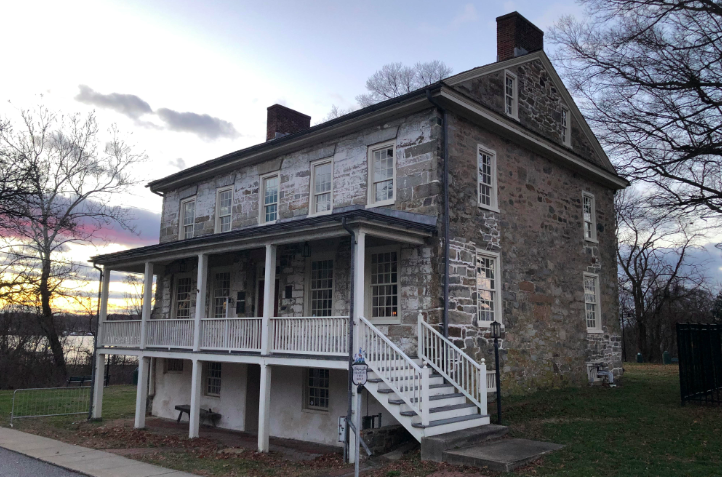Article Written by David Murch
A substantial house built in the Georgian Renaissance (British Baroque) style sits nestled away down a small road in Perryville, Maryland. Located adjacent to the classical Veterans Administration Campus, this stone structure sits grand and statuesque, an architectural time capsule bookmarking its position in history and physical location on the Susquehanna River. This is Rodgers Tavern Museum.
For those looking to more meaningfully connect on a deeper level with their local heritage, Rodgers Tavern Museum represents the last remaining structure of what was once a thriving commerce and military settlement on the east side of the Susquehanna River, directly across from the Town of Havre de Grace. Many know Havre de Grace, or Grace Harbor as the English translation goes, and have seen the proud statue of the French General Marqui de Lafayette who gave the town its namesake. So, when the intellectual and revolutionary giants of the 18th century, like Lafayette, Washington, Hamilton and even Rochambeau have local roots, rightfully this history is worth examining further.
Located at 249 East Broad Street, Rodgers Tavern Museum, completed in 1790, “is the sole survivor of the early settlement of this area, facilitated by travel along the post road between Baltimore and Philadelphia. The stone tavern sits along the east bank of the Susquehanna River, near the site of the ferry established in 1695, linking what later became Perryville and Havre de Grace. Opening as the Ferry House, it was purchased in 1780 by John Rodgers. It became a favorite stopping place for such notable Revolutionary War figures as George Washington and French generals Lafayette and Rochambeau” (Davidson & Lavoie).
What did these figures talk about, and what topics did they discuss? Surely, Washington, Hamilton, Lafayette and Rochambeau were conducting strategic meetings as they coordinated military and supply movements in the face of the British incursion. At Rodgers Tavern, the seeds of America were being sown in the candlelit rooms of grave and purposeful discussions among men who would be called “revolutionaries”. Indeed, the main goal in mind was independence, and that goal they surely achieved.
Originally known as Stevenson Tavern, the structure was the site of the raising of the 5th Company of Maryland Militia of the Revolutionary War, headed by none other than Colonel John Rodgers. Fascinatingly, Colonel Rogers was charged with raising (upon a direct recommendation from Washington and then ratified by Congressional order) a militia consisting of men from Maryland, Delaware and Pennsylvania, then colonies. Thus, at this early phase of the conflict, Colonel Rodgers raised one of the first “Flying Camps” which represented an able battalion of 10,000 colonists, now soldiers, to be a lean and agile mobile unit whose primary objective would be to defend large tracts of territory from the British.
According to Gene Pisasale, American historian, author and lecturer, “It wasn’t just Washington who slept there; numerous other Founding Fathers and supporters of the American cause, including Thomas Jefferson, James Madison, the Marquis de Lafayette and Marshal Jean-Baptiste Donatien de Vimeur, the comte de Rochambeau, whose French troops were vital to Washington’s victory at the historic Battle of Yorktown also spent time at Rodgers Tavern.”
The fledgling alliance between the colonial revolutionaries and the French intellectual and military elite alliance represented the cross-section of mutual interests being driven by political forces, but also the intellectual spring of thought originated during The Enlightenment, where in Paris, patriots and thinkers would convene at taverns to discuss the state of things, in what would eventually be known as the French “salons”.
Thus, a historic alliance was built and forged at Rodgers Tavern, and as we now know, America would emerge victorious against the British, finally winning our Independence. So, miles across the Atlantic, on the Susquehanna River between a small ferry crossing, the United States was being formed. We are fortunate to have the opportunity to celebrate and honor the historical significance of Rodgers Tavern Museum in Perryville, MD.
Source: “Rodgers Tavern Museum (Rodgers Tavern)”, Lisa Pfueller Davidson and Catherine C. Lavoie, Society of Architectural Historians (SAH), Archipedia Rotunda
Source: “Rodgers Tavern—a stopover point for our Founding Fathers”, Gene Pisasale & Tricia Hoadley, Cecil County Life, Dec 2019
Read the full VOM Spring 2024 Magazine Here: https://www.veteransoutreachministries.org/vom-magazine/


